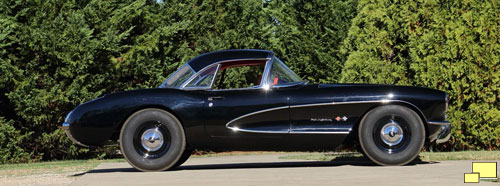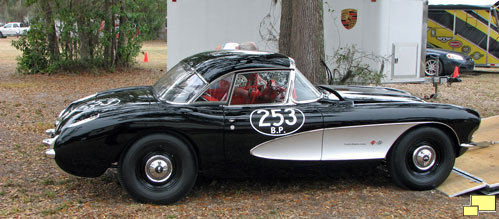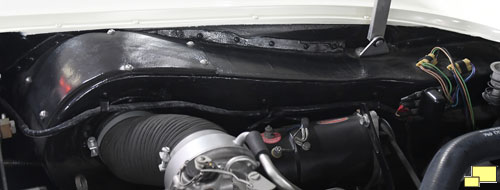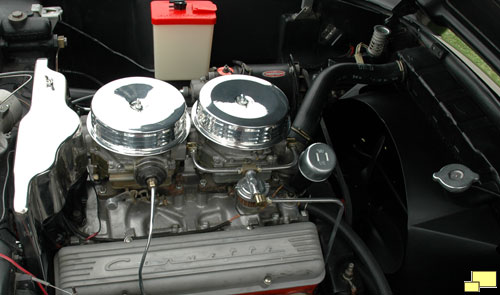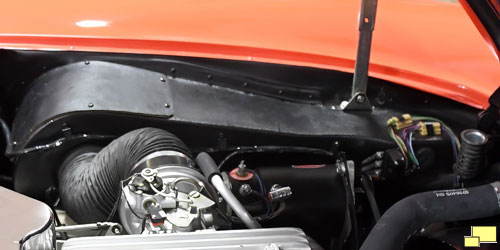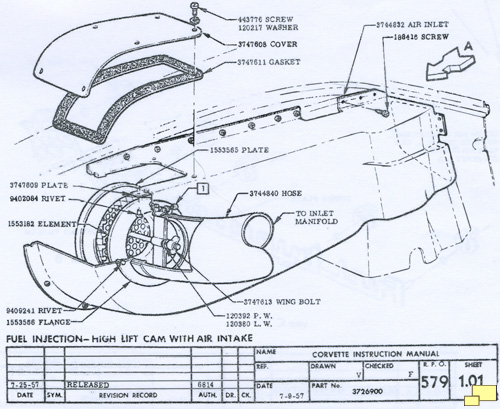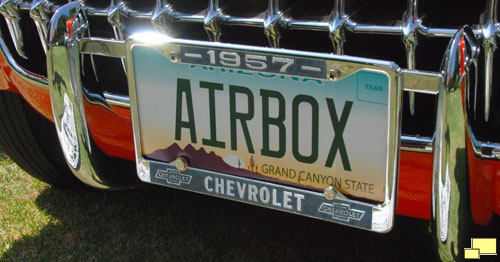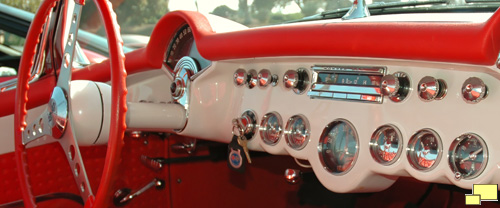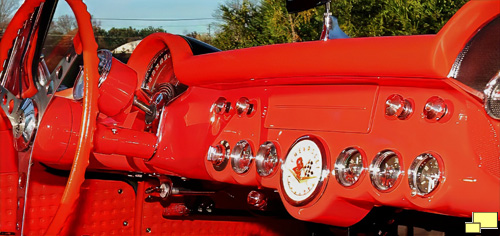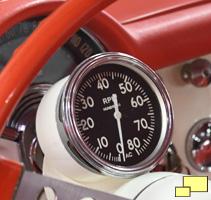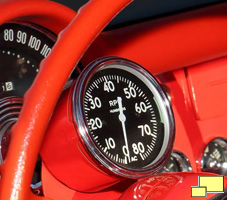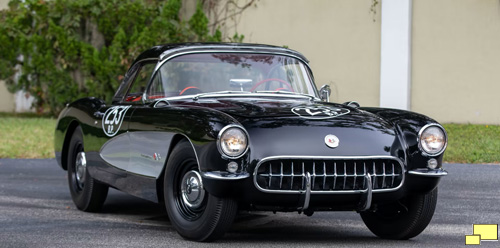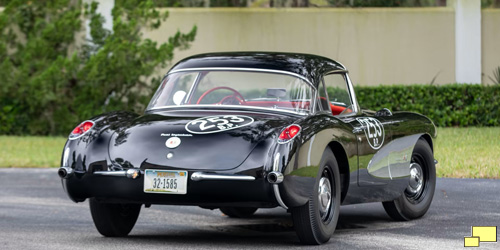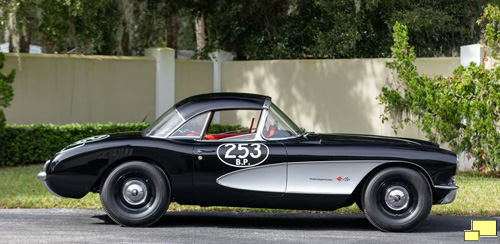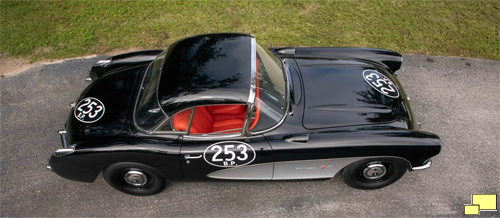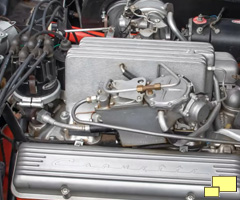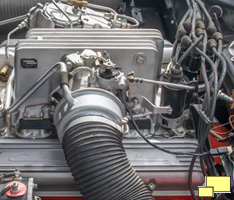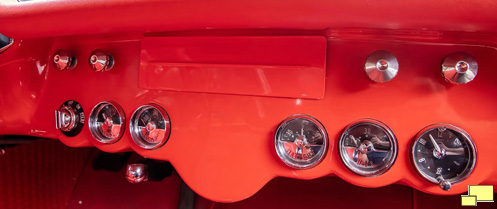Corvette Generations:
C1 C2 C3 C4 C5 C6 C7 C8
Corvette: Year by Year
1953 1954 1955 1956 1957 1958 1959 1960 1961 1962 19631964 1965 1966 1967 1968 1969 1970 1971 1972 1973 1974
1975 1976 1977 1978 1979 1980 1981 1982 1983 1984 1985
1986 1987 1988 1989 1990 1991 1992 1993 1994 1995 1996
1997 1998 1999 2000 2001 2002 2003 2004 2005 2006 2007
2008 2009 2010 2011 2012 2013 2014 2015 2016 2017 2018
2019 2020 2021 2022 2023 2024 2025
1957 Airbox Corvette
Here's a question worthy of debate: What is the most desirable and collectable Corvette?
There is of course no absolutely correct answer; there are many opinions on the subject and it all comes down to personal taste and preferences.
Your author has a definite opinion and that would be the 1957 Airbox Corvette. It was a cold air induction system which was (and still is) a popular and effective method of upping horsepower by arranging for the engine to be fed cold air.
The Corvette Black Book says that 43 were built but there are rumors of up to 50. Approximately 22 are known to exist. The airbox Corvette is a true race car that was often campaigned "back in the day". The life of a race car in the '50s and '60s was not an easy one; to make things worse they were not thought of as valuable then so their survival rate was low.
It was a one year only option for '57 with the Code moniker of 579D. Some documentation listed 579E as the Code. The intention was a racing only option as all were built without radios, EMI ignition shielding, heaters, power tops and windows, courtesy lights and windshield washers. There was a 579D Code for 1958, but it was only a fuel injected induction and did not include an airbox.
The airbox works by channeling cold air from ahead of the radiator directly to the intake on the fuel injection system. That air is colder and cold air is more dense which enhances horsepower. Most Corvette engines of the era took in air directly above the induction system - see the below photo. This was air heated by the engine - not good for performance.
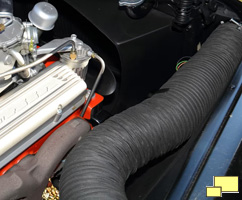 All airbox Corvettes had code 684 (Heavy Duty Racing Suspension) which included ducting for brake cooling on the right side of the engine compartment. The cooling air was channeled through the right side rockers to the front and rear brakes. The airbox itself also channeled air to the front and left rear brakes. Drum brakes were what was available in Corvettes in 1957 and, for racing applications, keeping them cool was critical.
All airbox Corvettes had code 684 (Heavy Duty Racing Suspension) which included ducting for brake cooling on the right side of the engine compartment. The cooling air was channeled through the right side rockers to the front and rear brakes. The airbox itself also channeled air to the front and left rear brakes. Drum brakes were what was available in Corvettes in 1957 and, for racing applications, keeping them cool was critical.
To further the case for racing applications, most (if not all) airbox Corvettes came with Code 684, the Heavy Duty Racing Suspension of which 51 were built at a cost of $781.10. The option, which was available on 1957 to 1959 Corvettes, consisted of Heavy Duty Springs and Shocks, Vented Brake Backing Plates, Finned Brake Drums, a Fast Steering Adapter, Heavy Duty Sway Bar and 5-1/2 inch Wide Wheels.
The generator, normally located on the left of the engine bay, was relocated to the right to clear up room for the airbox.
Airbox illustration from the 1956 - 1957 AIM (Assembly Instruction Manual). In addition to being installed on 43 1957 Corvettes, the parts were available from the parts department, enabling others to take advantage of the technology. All airboxes were constructed of fiberglass.
Above is the stock dash for the production 1957 Corvette. Note the tachometer in the center; the joke of the day was that the passenger had a better view of the tachometer.
Below: Corvette racers do not have a sense of humor when it comes to important details like instrumentation. All airbox Corvettes had tachometers mounted on the steering column. The previous dashboard location was filled with a trunk emblem.
SN 4007
The First Airbox Corvette
SN 4007 (the full VIN is VE57S104007) is the the earliest known airbox Corvette, completed May 15, 1957.
SN 4007 has an impressive list of awards, including being part of the Bloomington Gold Special Collection, Ault Park Concours d'Elegance Award of Distinction, multiple NCRS Top Flight Awards and being inducted into the Bloomington Gold Great Hall as one of the most significant cars in Corvette history.
SN 4007 airbox Corvette was on the auction block at Mecum on January 12, 2019 and was bid to $500,000 but the reserve was not met. More information available at the Vette-Vues Magazine web site. All photos of SN 4007 are courtesy of Mecum Auctions.
Above: The passenger side ducting located on the engine compartment that sent cool air to the right side brakes.
Two views of the SN 4007 fuel injection system. Note the absense of EMI shielding on the spark plug wires and distributors. All airbox Corvettes, being radio delete, did not require the shielding.
SN 4007 dashboard. Note the blank area where the stock Corvette would have a tachometer. Apparently, with it being a prototype of sorts, nobody thought to install the trunk emblem in its place as was done on later airbox Corvettes.
Note: Clicking on an image with this symbol ( ) will lead to a larger image.
) will lead to a larger image.


